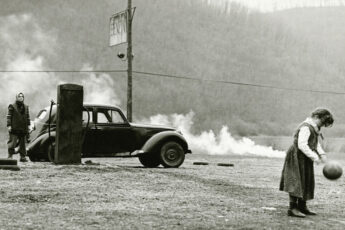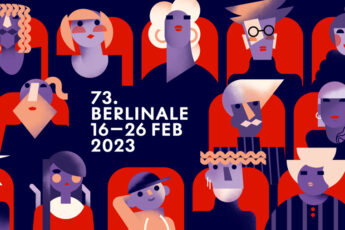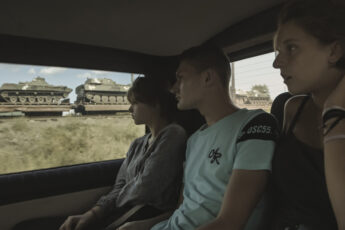"We Used to Be One."
Vlad Petri’s Between Revolutions (Între revoluții, 2023)
Vol. 133 (March 2023) by Anna Doyle
During recent protests in Iran, students from both university and high school took to the streets in response to the death of Jina (Mahsa) Amini, a 22-year-old Kurdish woman who had died after being taken into custody in Tehran for wearing an “improper” hijab. Despite facing police brutality, students are now taking their hijab off and walking in the streets of Teheran demanding gender equality. In Romania, too, women are in the process of finding their own voice after a long period marked by patriarchal dictatorship. In the meantime, the rights of ethnic and sexual minorities have been brought to light in Romania in recent years. The gay community had had to wait until 2001 for the implementation of Article 200 and the legalization of public displays of homosexuality after years of harsh repression, and yet, ever since, the plight of the LGBTQ+ community has only become more evident. In addition, both Iran and Romania appear to be navigating a complex geopolitical position tainted by the Cold War, the lasting legacy of dictatorships, and the global capitalist system. Vlad Petri’s comparative historical film essay Between Revolutions, which screened in the Berlinale’s Forum section this year, calls to mind the complexities of the two countries’ (geo)political, historical and social reality.
It is not surprising that Vlad Petri chose two students as the protagonists of his film, as both lived through the political turmoil in Iran and Romania from the 70s through to the 90s at an age that is often considered to be the most politically active period of one’s life. The film is a dialogue built around archival footage from Iran and Romania in the period starting from before the Iranian Revolution (1979) through to the 90s and the collapse of the Romanian dictatorship of Ceaușescu. The film’s voiceover centers around the friendship of two students – Maria, hailing from Romania, and Zohra, from Iran, two young women who studied medicine at the Medical School in Bucharest before Zohra moved back to Iran just before the outburst of the Iranian Revolution. Petri had found the two students during archival research and devised a fictitious correspondence between them with the help of Lavinia Branişte. The sound and images are not directly connected, but the correspondence’s depth and poetic imagery (if sometimes flowery), links the powerful historical images with the two characters’ intimate and decidedly feminine perception of political unrest. Vlad Petri’s film is a touching story of togetherness that defies violent separation. How does one unite in the midst of political crises, geographical divides, gender gaps, and oppressive regimes? The story of these two young women, whose relationship is ambiguously queer, is punctuated by the poetry of two important women writers: Forough Farrokzhad, well-known for her lyrical poetry and for making the masterpiece of the Iranian New Wave, The House is Black, and Nina Cassian, a Romanian poet who later in her life sought asylum in the US after openly criticizing the Communist regime in her poetry. A sub-dialogue between these two female figures of poetic liberation is superadded to the fictional dialog between the two protagonists of the film.
Politics and intimacy intermingle in Between Revolutions. By juxtaposing propaganda footage with amateur-seeming images of the everyday, Petri attempts to question the patriarchal gaze within these two societies. We see rare footage ranging from the Iranian revolution, with people crying for emancipation from the Shah, to the repression of women by the Khomeini supporters. We witness the transformation from a veil-less culture before the revolution to a society where women might lose their lives if they refuse to wear the hijab – all images form a striking vision of this pivotal period. Women are not only depicted as victims of the revolution, they are also pictured as fighters, as there was a massive participation of women in the 1979 revolution, which was partly a result of the mobilization efforts of women’s organizations in the preceding decades. At another moment of the film, women fighters in the Iran-Iraq War are seen holding their guns, women who are later described as “grenades with fragile hands”.
The footage from Communist Romania, which is intercut via parallel montage, concentrates primarily on the everyday struggles of women. There are images of elegant women divers, of women leisurely sunbathing at the beach, and footage that points to the lingering threat posed by men on the streets. The contrast between footage of food shortages in Romania and the propaganda images of a grandiose, gymnastic parade in Communist Romania, is representative of people’s disappointment with Communist life as it was actually unfolding. In between two revolutions, with the Communist ideal being decoyed, the voice of Maria says, “We fear for our jobs, we’ve lost our bearings.” The minor everyday efforts of these women to understand what is happening to them in between the two revolutions are signs of a bigger battle: the one against the oppressive paternalistic structures of these societies. Higher-education students, especially women, were considered as menaces in both societies – the Romanian Securitate liked to refer to “dissident” students who were opposed to the philosophy of the Romanian Communist Party as “intellectuals”. The film is convincing in comparing what is publicly displayed with the ways that everyday life is experienced by regular people, and how the public and the private clash severely at times when women are not allowed to freely write or think.
The illusory nature of revolution in the film brings out the gap between political ideals and harsh reality, with the struggle for emancipation not turning out the way it was first imagined. The death of Zohra’s father is an example of this fatal disappointment – her father is the one who had taught Zohra the meaning of freedom, but then he himself lost his life to the state apparatus of the Islamic Republic. A revolution opens a new world, it is a disruption of an old world, but it is obvious that the new does not always bring good – such is the dramatic outcome of any crisis, as reflected in the Greek term “krisis”, a medical term referring to the decisional moment where a disease can either turn better, or worse.
The epistolary conversation between Maria and Zohra shows how much individual destinies are shaped and blinded by their contemporary history, but how they are also able to resist ideology in their ultimate privacy. The two women form a bond whose closeness almost makes them appear as a single person despite their geographical separation. The film ends on the words, “We used to be one, we used to be one.” Each of the women hears the voice of the other while reading their letters, “I think it’s my own (voice), it’s myself in my head.” The double nature of a letter being both a diary-like intimate monologue and a text genre that is in its very nature addressed to somebody, stresses the emotional bond between two women whose letters are both an impassioned outlet for their opinions and a cry for empathy. The third person of this dialogue being the spectator itself, the story should be told so as not to “fade away from paper”, says the voice. Here, the enduring fragility of paper translates into the perennial delicacy of the archives offered to us spectators.
Despite being based on documents in the Romanian Secret Police archives, the correspondence between the students is fictional. It was in fact written by acclaimed Romanian writer Lavinia Branişte. The end of the film shows official documents of Iranian and Romanian students to uphold the illusion that the story of these two women is true. Though the correspondence does refer back to research and the poetic intonation of the letters is absorbing and engaging, its fictionalization could be deemed as problematic as in any historical reconstruction, as it does project somewhat contemporary expectations of what the past was like, no matter how private and intimate the story may be (take the ambiguous queer relationship between the two women or their embellished sense of togetherness, with found-footage accompanied by entrancing 70s Iranian music and popular Romanian songs). Perhaps reading the story of these two women as an allegory of the struggle to bridge borders, to find unity beyond separation and crises, helps avoid the anachronism of the story. Vlad Petri’s last film, The Same Dream, similarly relied on fictional elements by filling in the details of a factual encounter between a child and soldiers in Afghanistan. Incidentally, the film also drew parallels between Romania and Afghanistan.
One must remember that the execution of Ceaușescu and Romania’s revolution happened just after the Romanian dictator had returned from a visit to Tehran. Romania and Iran had established a strong connection during Ceaușescu and Khomeini’s regimes, with both being on difficult geopolitical terms with the US as well as the USSR. Towards the end of the film, we see American flags being burned in both Iran and Romania, a striking image of the common geopolitical and cultural enemy of these two countries. The US and what it represents is not only far removed from the geopolitical agenda of these two dictatorships and thus considered an enemy – its superpower status also symbolizes the emergence of neoliberalism during the Cold War. For those who believed in revolution, the US and the system it championed were obstacles to their own independence. The dissolution of the Ceaușescu dictatorship at the end of the film could seem positive in opposition to the 1979 Iranian Revolution, but Vlad Petri succeeds in showing the insidious opening of post-Communist Romania to capitalism, with the fascination with Western culture, Coca Cola, mini-skirts, and convertible cars turning out to be just another kind of cultural imprisonment.
Vlad Petri’s aesthetic approach is not new. The archival turn has been an important movement in contemporary art, experimental cinema, and documentary cinema, with directors letting anonymous silent images speak – either for themselves or as supplementary material. Behind the illusion of archival objectivity, viewers are invited to question “ways of seeing” that are inscribed in historical psyches. Oftentimes, the editing will ironically reverse the views of social issues presented through the footage, especially if their source is official. A topical approach is pursued in The Autobiography of Nicolae Ceaușescu, a 2010 documentary found-footage film by Andrei Ujică that the director compiled from official archive footage. The images document Nicolae Ceaușescu’s family life and the rise and fall of his government through the lens of his own propaganda. In the same vein, Adam Curtis’s recent Traumazone tried to take a fresh look at the collapse of the Soviet Union. Curtis edited amateur and propaganda footage from the former Soviet Union and post-Soviet Russia without adding any voice-over. For an example with a contemporary setting, take Bani Khoshnoudi’s fascinating collection of gathered images, The Silent Majority Speaks (2010), in which diverse cameras film the martyrs of the suppressed resistance movements that happened after the 2009 Iranian presidential elections (the so-called “Green movement”), reflecting not only on violent political oppression but also on the problem of image censorship.
Between Revolutions is a lyrical depiction of the rise and fall of ideologies, and the development and subsequent dismantling of dreams in the course of revolutionary upheaval. Connecting archival images of Romanian Communism and the Islamic revolution in Iran reveals what they secretly might have had in common. Revolutions of the past are a prism for contemporary thinking – what could a comparison between Romania and Iran mean for the movement against the structural misogyny of the current Iranian regime? The period between revolutions presents people with a turmoil of rising emotions and desires. The film asks what the roles of women are in such times of upheaval, a question that has often been disregarded to extol the figure of the revolutionary hero and martyr. It is an appropriate time to wonder about the ones who look at the revolution from a distance, who live through it without participating in the action, who write letters of worry, lyrical poetry, sometimes not choosing to side with a party or concrete ideology. Could such observers also be counted as pacific agents of change?




Leave a Comment